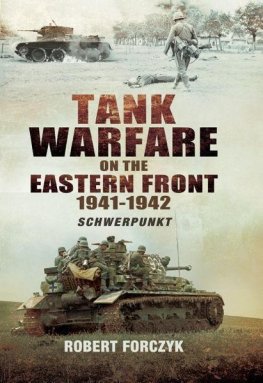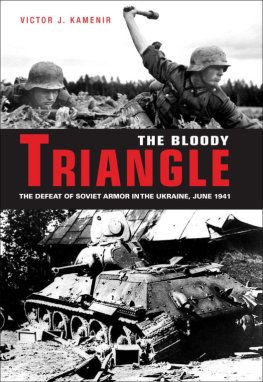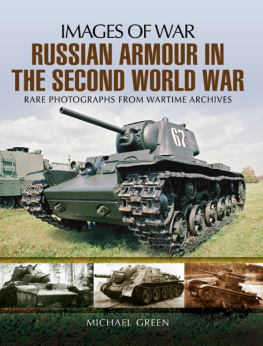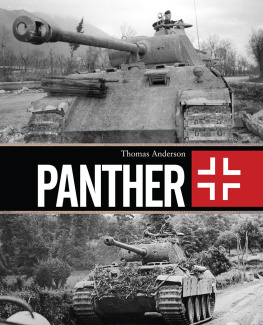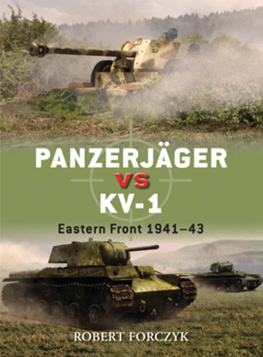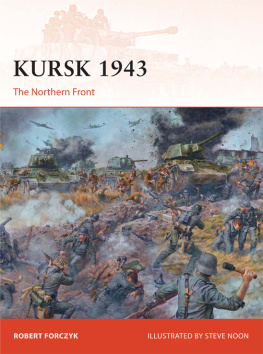The Tanks of Operation Barbarossa
The Tanks of Operation Barbarossa
Soviet versus German Armour on the Eastern Front
Boris Kavalerchik
Translated by Stuart Britton
First published in Great Britain in 2018
by Pen & Sword Military
An imprint of Pen & Sword Books Limited
47 Church Street
Barnsley
South Yorkshire
S70 2AS
Copyright Boris Kavalerchik 2018
ISBN 978 1 47388 680 3
eISBN 978 1 47388 682 7
Mobi ISBN 978 1 47388 681 0
The right of Boris Kavalerchik to be identified as Author of this Work has been asserted by him in accordance with the Copyright, Designs and Patents Act 1988.
A CIP catalogue record for this book is
available from the British Library.
All rights reserved. No part of this book may be reproduced or transmitted in any form or by any means, electronic or mechanical including photocopying, recording or by any information storage and retrieval system, without permission from the Publisher in writing.
Illustrations by Yuri Kavalerchik.
Pen & Sword Books Limited incorporates the imprints of Atlas, Archaeology, Aviation, Discovery, Family History, Fiction, History, Maritime, Military, Military Classics, Politics, Select, Transport, True Crime, Air World, Frontline Publishing, Leo Cooper, Remember When, Seaforth Publishing, The Praetorian Press, Wharncliffe Local History, Wharncliffe Transport, Wharncliffe True Crime and White Owl
For a complete list of Pen & Sword titles please contact
PEN & SWORD BOOKS LIMITED
47 Church Street, Barnsley, South Yorkshire, S70 2AS, England
E-mail:
Website: www.pen-and-sword.co.uk
Introduction
T anks brought about a revolution in military affairs and in a fundamental fashion changed the nature of conducting warfare. From the moment of their first appearance on the fields of battle, they attracted the interest of a multitude of people and continue to do so. However, to a great extent due to such elevated, general interest, numerous myths and legends have grown up around these combat vehicles, which often hinder a view of their genuine essence. In the mental image of some people, tanks have turned into a form of wonder-weapon, capable of independently deciding the outcome of any battle.
In this connection the answer to a long, painful question is interesting: what then caused the Red Armys catastrophe in the border battles of 1941? Alternative explanations have appeared in response to this question, and new ones continue to appear. In the list of its main reasons, Soviet official historiography cited the numerical superiority of the Wehrmacht in tanks. Stalin set the tone for this when he declared in a report to a session of the Moscow City Council on 6 November 1941: the reason for the temporary setbacks of our army consists in our lack of tanks and partially of aircraft. Our tanks are superior to the German tanks in quality, and our glorious tankers and artillerymen have more than once put the much-vaunted German troops with their multitude of tanks to flight. Even so, we have several times fewer tanks. In this lies the secret of the German armys temporary successes. available armoured fighting vehicles were totalled, while for the USSR only the new types of heavy and medium tanks, the KV tank and the T-34, were counted. At the same time, the latter tanks were called unequivocally the best tanks in the world, much superior to their German counterparts according to every criterion. In contrast, with one stroke of the pen all of the Red Armys other tanks were dismissed as light and outdated models that had extreme limitations due to the short operating lifetime of their engines, which were also prone to catch fire. On this basis they were usually not even included in the calculations, as if they had no sort of combat value.
Meanwhile, facts that directly contradicted such humiliating characteristics of the pre-war Soviet armour were deliberately hushed up. For example, the hundreds of medium T-28 tanks available in the war, the serial production of which ended only a year before the beginning of the Great Patriotic War (the war on the Eastern Front), were for that reason undeservedly forgotten. It wasnt mentioned that the majority of these supposedly outdated tanks were not more than five years old. What then made them outdated and prevented them from being used to carry out basic combat assignments? This reasonable question, for understandable reasons, remained unanswered. The situation with the wearing-out of the tanks was also far from simple. Supporters of the official Soviet version were intentionally or unwittingly ignoring the system of conserving the service lives of combat vehicles that was adopted and implemented in the Workers and Peasants Red Army (RKKA) long before the war. In fact the main culprit in the frequent breakdowns of the Soviet tanks early in the war was not their short service life, but their low reliability from the outset, the main reasons for which were engineering flaws, the poor quality of production and the unsatisfactory technical service. Moreover this related to all of them, and not only to tanks of older types, but well discuss this in more detail later. Well also discuss the tendency of the tanks to catch fire, but here well only note that all of the serially produced German tanks of the Second World War, without exception, were equipped with carburettor engines that operated on petrol. In this respect they were just as prone to fires as the older models of Soviet tanks.
History has repeatedly shown that even a substantial numerical superiority in force and means far from always guarantees a victory in armed struggle. A lot depends on the correlation of qualitative characteristics of the opposing forces. This is just as true in the case of tanks. Various, often directly contradictory, opinions exist as to whose tanks were better in the initial phase of the Great Patriotic War, German or Soviet. In order to answer this difficult question correctly, it is necessary to take proper consideration of what the tanks of the Wehrmacht and Red Army were really like; why they were made that way; how many there were; when the formations that were equipped with them appeared and how they evolved; the history of their use in wars and armed conflicts on the eve of the Great Patriotic War; how to compare them properly; and what factors had a decisive influence on the results of their combat use. This book is dedicated to answering these questions.
Chapter 1
The Main Factors that Determine the Design of Tanks
O ne of the most widespread mistakes is the tendency to look at tanks from former years from a contemporary standpoint and to evaluate them using modern criteria. Such an approach has its attractions: in the first place, it is simple, and secondly, it allows us to sense our superiority over the people of the past, who created and used those tanks, in which today we see so many imperfections and flaws. At the same time often the blaming of one or another detail of a tank for its shortcomings is in fact a result of the elementary misunderstanding of how, why and for what purpose each detail was made part of it from the beginning. It often isnt simple to determine the real plusses and minuses of one or another. Moreover, one and the same feature might in one case be a strong point, and in another case a shortcoming. The main point is that it must never be forgotten that every tank of all eras and nations without exception had both their positive and negative sides. Thus one mustnt issue snap judgements, only viewing the tanks from one side while putting some of them on a pedestal and tossing others into a waste bin entirely on the basis of some particular features that are taken out of context. It is much harder to look into the actual qualities and inadequacies of specific tank types, but also more interesting and useful for understanding them.


